Architektura pamięci – (nie)literackie przestrzenie getta
The architecture of memory – (non)literary areas of ghetto
Author(s): Małgorzata Wójcik-DudekSubject(s): Architecture, WW II and following years (1940 - 1949), History of the Holocaust, Politics of History/Memory
Published by: Wydawnictwo Uniwersytetu Komisji Edukacji Narodowej w Krakowie
Keywords: memory; ghetto; Holocaust; architecture; “fourth” literature;
Summary/Abstract: The author of the article makes an attempt to collocate and consequently show the similarities in the literary texts aimed at the young reader and the artistic projects connected with the area of the ghetto. The scholar notices that both literature and architecture use similar motives in spite of the fact that so diversified culture texts are directed to different age groups. Among common literary and architectural motives are: emptiness, cellar, limbo and confinement. All these are set in Martin Heidegger's philosophy oscillating around the symbolism of the flat, being rooted in tradition, lasting and creating.
Journal: Annales Universitatis Paedagogicae Cracoviensis. Studia Historicolitteraria
- Issue Year: 2014
- Issue No: 14
- Page Range: 215-224
- Page Count: 10
- Language: Polish

